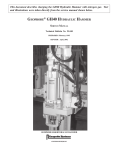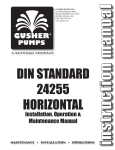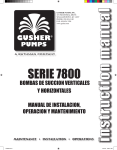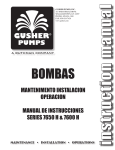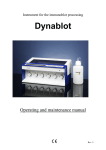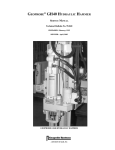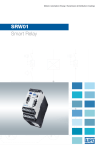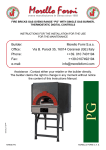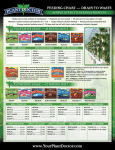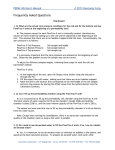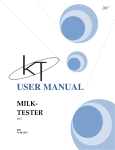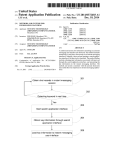Download DIN Manual - Gusher Pumps
Transcript
DIN STANDARD HORIZONTAL END SUCTION CENTRIFUGAL PUMP SERIES Installation,Operation and Maintenance Manual Table of Contents Operating and Service Manual for DIN END SUCTION CENTRIFUGAL PUMP SERIES FOREWORD ...................................................... 3 GENERAL INFORMATION ................................... 4 RECEIVING AND INSPECTION ............................... 5 INSTALLATION .................................................. 6-7 OPERATION ..................................................... 8-9 DRAWINGS DIN 1 POWER FRAME ........................... 10 DIN 2 -3 POWER FRAME ......................... 11 PACKING SEAL ......................................12 CARTRIDGE SEAL ...................................12 CLOSED COUPLED STYLE ........................13 CDM STYLE ...........................................13 MALFUNCTIONS / CAUSES...................................14 SPARE PARTS RECOMMENDATIONS........................14 PUMP TIPS .........................................................15 This manual is for a reference guide only. Pumps are built in many variable configurations and with different options. Please consult with the factory for more information regarding your individual product. 2 Forward Operating and Service Manual for DIN END SUCTION CENTRIFUGAL PUMP SERIES The design, craftsmanship and materials used in Gusher Pumps provides for optimum performance and long, trouble-free service. As with any mechanical device, proper use and periodic maintenance will enhance the performance and life of your pump. This manual is provided as a guideline for proper installation, operation and maintenance. THIS MANUAL MUST BE READ AND UNDERSTOOD BEFORE INSTALLING AND OPERATING ANY PUMP. Supervision by an authorized Gusher representative is recommended to insure proper installation. ! This operating and maintenance manual contains important notices and warnings. Please read carefully before installation, electrical connection and initiation. Further instructions concerning the components of the pump must be observed. WARRANTY Gusher Pumps, Inc. will replace or repair at our discretion, within one year of shipment from our plant, any pump in our judgement that has failed due to defects in materials or workmanship, provided the pump has been properly installed and maintained and has not been subjected to abuse. These pumps must be returned to Gusher Pumps, Inc. with complete history of service for inspection and warranty consideration. Gusher Pumps, Inc. does not accept the responsibility for transportation to and from our plant. Furthermore, we do not assume any responsibility for consequential damage or loss of production. Warranty is only valid if genuine Gusher parts are used. CONTACT GUSHER: 22 Ruthman Drive, Dry Ridge, Kentucky, USA 41035 PH: 859-824-5001 FAX: 859-824-3011 www.gusher.com 3 General Information Heavy-Duty Casings All sizes are self-venting with centerline discharge. All sizes have drain plugs. Heavy-Duty Shaft-minimum deflection increases life for less maintenance. Wear Rings Renewable carbon wear rings. Shaft Sleeve - Renewable Shaft Sleeve eases maintenance (easily removed) and is releaved to allow for changes in temperature. Lubrication: Standard pumps are with sealed for life ball bearings. Oil Lubrication is optional Grease Lubrication is optional Direction of Pump Shaft Rotation: Clockwise when viewed from coupling. Counter clockwise when viewed from pump inlet. Rabbeted Fits-Accurately machined rabbets ensure positive alignment, longer seal life, easy replacement of spare rotating element when maintenance is required. Contained Casing Gasket-Protects against blow-out. 3 POWER FRAME SIZES: MODELS WITH DIN 1 POWER FRAME 32-125 40-125 50-125 65-125 32-160 40-160 50-160 65-160 32-200 40-200 50-200 65-200 32-250 40-250 50-250 80-160 MODELS WITH DIN 2 POWER FRAME 40-315 50-315 65-250 80-200 80-250 80-215 100-200 100-250 100-315 100-250 150-200 150-250 65-315 100-160 125-200 MODELS WITH DIN 3 POWER FRAME 80-400 150-315 100-400 125-315 150-400 125-400 Nameplate Information On every Gusher pump is a nameplate that provides information: 1) The pump’s hydraulic characteristics 2) Pump model number 3) Impeller number and diameter 4) Serial number Since over time, these nameplates can become damaged or removed, it is recommended that all name plate information be recorded for future reference. Having this information will insure proper spare parts or a replacement pump are supplied. 4 Receiving and Inspection Gusher Pumps, Inc. has taken great care in preparing your pump for shipment, However, due to circumstances beyond our control, your shipment may be received damaged. Therefore we strongly recommend you take a few minutes to check your pump upon receipt. Check for cracked, bent, severely misaligned (minor misalignments almost always occur during shipment), or even missing parts. If any such damage has occurred, you must report it to the delivering carrier and Gusher Pumps, Inc. immediately. We also recommend that you check the model number, horsepower, current characteristics, g.p.m., and ft. head of the pump received to insure that you have received the pump you ordered for your specific operating conditions. if you should find some discrepancy, report it to Gusher at once. Storage If your pump is not going to be installed within six months, several precautions must be taken: 4. Pump suction and discharge points must be covered to prevent foreign material from getting into the pump and causing damage while the pump is started at a later date. 3. Pumps must be stored in a dry location. 4. Rotate pump shaft several times every other month. Handling ! WARNING ! Pump and components are heavy. Serious physical injury or damage to equipment should occur from failure to properly lift and support pump. Steel-toed shoes must be worn at all times. Use care when moving pumps. Lifting equipment must be able to sufficiently support the entire pump. Refer to Figs. 2a, b, c for proper lifting techniques. FIG. 2a 1. Preservative treatment of bearings and machined surfaces is required. (Not required for sealed for life ball bearings). 2. Remove packing on pumps with stuffing box. The stuffing box and shaft sleeve must be oil lubricated to also protect against moisture. FIG. 2b FIG. 2c 3. Units equipped with mechanical seals must also be lubricated with an oil can through the NPT port while rotating the shaft by hand. 5 Installation PREPARATION When preparing your pump for installation, the discharge and suction ports must be clean and free of anything that might prohibit a tight connection. This is especially important on the suction. Air leaks can cause a pump to operate poorly or to lose prime completely. If your pump has been taken out of storage, all the grease, oil or preservative must be removed from the ball bearing housing. The bearing housing must then be thoroughly cleaned with kerosene or carbon tetrachloride and relubricated. This is not required on sealed for life bearings. On packed pumps, it will be necessary to clean the shaft sleeve and stuffing box with kerosene or carbon tetrachloride and then repack. LOCATION / FOUNDATION Whenever possible, locate the pump far enough below the minimum liquid level in the resevoir so there will be a positive head on the suction at all times. Where this is not possible, the pump should be located as near to the source of supply as possible. Allow ample room for inspection and maintenance. The foundation should be of heavy construction to reduce vibration and must be rigid enough to resist the torque it may be subjected to. LEVEL BASEPLATE Customers mount the bases in a variety ways. Grouted, welded to other steel, bolted to concrete floor, etc. It should be noted at this time that SPECIAL CARE must be taken when leveling your pump base for coupling alignment, This is of the utmost importance. Once the base is in place and before securing the base, the coupling alignment should be verified. The coupling alignment should be checked again once the base mounting is finished. After the base is mounted, the only way to adjust the coupling alignment is by adding or removing shims underneath the motor feet. Level baseplate to within 0.125” over the length and to within 0.062” over the width by adjusting the wedges. COUPLING ALIGNMENT ! WARNING ! Before starting any alignment procedure, ensure that the motor power is locked out. Failute to do this will result in serious physical injury. For trouble-free operation of this unit, proper alignment must be attained. Proper alignment is the responsibility of the installer and user of this pump. 6 Coupling alignment should be checked and verified: 1) Base installed but not secured 2) Base in place and secured 3) After connecting the system piping 4) Before start-up of a system Review page 9 for coupling alignment specifications. Installation SYSTEM PIPING Guidelines for piping are given in the “Hydraulic Institute Standards” available from the Hydraulic Institute, 30200 Detroit Road, Cleveland, OH 44145-1967. These guidelines should be followed to ensure proper pump operation. ! WARNING ! Never force piping into position by pulling it place with the pump suction and discharge flange bolts. This will cause misalignment between pump and driver which will adversely affect the operation of the unit, resulting in physical injury and damage to the equipment. 1). All piping must be supported independently of the pump. 2). Before connecting the piping to the pump, ensure that the base is secured. 3). Clean all pipe parts prior to installation. Suction Piping ! WARNING ! NPSHA must always exceed NPSHR as shown on Gusher performance curves. Reference Hydraulic Institute for NPSH and pipe friction values needed to evaluate suction piping. Properly installed suction piping is necessary for trouble-free pump operation. Flush suction piping before connection to the pump. 4). Liquid coming back into the resevoir should not enter near the pump suction pipe and the liquid should not drop from a high level. 5). An isolation valve should be installed in the suction pipe at least 4 pipe diameters from the suction to allow closing of the line for pump inspection and maintenance. 6). Pipe should be free of air pockets. 7). Piping should be level or slope gradually downward from the source. 8). No part of the piping should extend below pump suction flange. 9). The size of the entrance from the supply should be one or two sizes larger than the pipe. Discharge Piping 1). A gate valve and check valve should be installed in the discharge line. The check valve should be installed between the gate valve and the pump. This will allow for inspection of the check valve. The gate valve is required for priming, flow regulation and for maintenance of the pump. The check valve is required to prevent pump or seal damage from reverse flow through the pump when the motor is turned off. 2). If quick closing valves are installed in the system, cushioning devices should also be installed to protect the pump from surges and water hammer. 1). Never place a pipe line elbow in the horizontal plane directly at the pump suction. Use a straight pipe four to six pipe diameters long between the elbow and the pump suction. 3). A pressure gauge should be installed in the piping just above the pump discharge. This gauge should be located at the pump discharge and before any valves, elbows or other devices. 2). Use suction pipe one or two sizes larger than the pump suction, with an eccentric reducer, sloping slide down, at the suction flange. Suction piping should never be smaller than the pump suction. Final Piping Check After all piping connections have been made to the pump: 3). Never throttle the pump on the suction side. Always control flow by throttling on the discharge side of the pump. 1) Rotate the shaft by hand to insure that there is no binding and all parts are free. 2) Re-check pump alignment to detect any pipe strain. If pipe strain exists, correct piping. 7 Operation PREPARATION FOR START-UP Check Rotation 1). Wire the motor according to motor manufacturers specifications and according to state and local regulations. 2). Lock out power to driver. 3). Disconnect motor/pump shaft coupling to prevent dry operation of the pump when checking rotation. ! WARNING ! Operating the pump dry will cause damage to the mechanical seal and may cause the rotating parts to seize. 4). Make sure everyone is clear. Jog the motor. Determine if the motor shaft rotation is correct. Refer to page 4 to determine proper motor shaft rotation. Correct if necessary. Couple Pump and Motor 1). Lock out power to motor to prevent accidental rotation and physical injury. 2). Install and lubricate coupling per manufacturers instructions 3). Verify coupling alignment. Review page 9 for coupling alignment specifications. 4). Install coupling guard. ! WARNING ! Never operate a pump without the coupling guard properly installed. Personal injury can occur if pump is run without coupling guard. INITIAL STARTING 1). Open all inlet piping valves 100%. 2). Open discharge valve 10-15% 3). Remove vent plug on casing to insure pump has liquid inside the casing. 4). Review pump nameplate and obtain the pressure the pump was rated for. 5). If your pump is packed, loosen packing gland screws to allow free leakage. Then tighten screws uniformly on packing gland until leakage is reduced to approximately 30 drops per minute. Never tighten packing enough to stop all leakage as a slIght leakage is required to lubricate packing and prevent scoring of shaft sleeve. 6). Start motor and immediately observe pressure gauges. If discharge pressure is not quickly attained, stop the pump and attempt to restart. If pressure is still not obtained, turn the pump off and investigate the cause. 7). Open the gate valve in the discharge line gradually as the motor reaches full speed. (approximately 5 to 10 seconds). Adjust valve to obtain the pressure reading as per the pump nameplate. 8). Check pump for vibration levels, bearing temperature and excessive noise. If normal levels are exceeded, shut down and investigate. OPERATION 1). Always vary the capacity with gate valve in the discharge line. Never restrict intake flow. 8 2). If the specific gravity of liquid being pumped is greater then originally assumed or if the rated flow is exceeded, the motor may overload. Operation OPERATION 3). Drain all liquid from inside of the pump if it will be exposed to freezing conditions while idle. The conditions could cause liquid to freeze and damage the pump. Liquid inside cooling coils, if supplied, should also be drained. 4). If your pump is packed, final leakage adjustment will be done with the pump in operation. Tighten screws uniformly on packing gland until leakage is reduced to approximately 30 drops per minute. Never tighten packing enough to stop all leakage...a slight leakage is required to lubricate packing and prevent scoring of shaft sleeve. 5). To prevent damage from cavitation or recirculation, always operate pump at or near rated conditions. ! WARNING ! DO NOT operate pump below minimum rated flows or with suction or discharge valves closed. These conditions could create an explosive hazard due to vaporization of pumpage and can quickly lead to pump failure and physical injury FINAL ALIGNMENT 1). Run the unit under actual operating conditions long enough for the pump and motor to reach operating temperature. 2). Check alignment while unit is still hot. 3). Make any necessary adjustments and reinstall the coupling guards. COUPLING ALIGNMENT PROCEDURE Alignment Criteria Angular Alignment Check angular alignment with a micrometer or caliper. Measure from the outside of one flange to the outside of the other flange at intervals around the periphery of the coupling. DO NOT rotate the coupling. The difference between the maximum and the minimum must not exceed .010”. Parallel Alignment Check parallel alignment by placing a straight edge across the two coupling flanges and measure the offset at various points around the periphery of the coupling. DO NOT rotate the coupling. If offset exceeds .010”, realign the coupling. Motor Shaft Motor Shaft Angular Misalignment .010 Parallel misalignment Straight edge Pump Shaft Pump Shaft 9 Power Frame 1 DIN 1 (SMALL) POWER FRAME Models for DIN 1 32-125 40-125 50-125 65-125 32-160 40-160 50-160 65-160 32-200 40-200 50-200 65-200 32-250 40-250 50-250 65-250 8 7 5 4 3 1 2 6 18 17 19 20 16 15 14 12 13 11 10 9 Part Number 1 2 3 4 5 6 7 8 9 10 Description Bearing Retainer Ball Bearing Shaft Ball Bearing Bearing Housing Pedestal Gasket Shaft Sleeve Seal Gland Part Number 10 11 12 13 14 15 16 17 18 19 20 Description Gasket Mechanical Seal Spacer Sleeve Stem Plate Gasket Impeller Drive Key Impeller Washer Impeller Locking Nut Wear Ring Impeller Housing Power Frame 2 & 3 DIN 2 & 3 (LARGE) POWER FRAME Models for DIN 3 Models for DIN 2 40-315 65-315 80-315 100-250 125-250 50-315 80-200 100-160 100-315 150-200 80-400 125-400 65-250 80-250 100-200 125-200 150-250 100-400 150-315 7 125-315 150-400 8 5 4 3 2 1 6 6 20 21 18 19 15 16 17 14 11 9 10 12 13 Part Number 1 2 3 4 5 6 7 8 9 Description Bearing Retainer Ball Bearing Shaft Ball Bearing Ball Bearing Housing Pedestal Gasket Shaft Sleeve Seal Gland Part Number 10 11 12 13 14 15 16 17 18 19 20 21 Description Gasket Mechanical Seal Locking Collar Stem Plate Gasket Wear Ring Impeller Drive Key Impeller Wear Ring Washer Impeller Locking Nut Impeller Housing 11 Seal Types CARTRIDGE MECHANICAL SEAL AND PACKING 1 1 2 2 CARTRIDGE TYPE Mechanical Seal Pump Number Description: 1...Cartridge Seal 2...Gasket 3 PACKING PUMP Number Description: 1...Packing Gland 2...Packing 3...Packing Seat Washer For all other parts descriptions, refer to pages 10 and 11 This illustration is for reference only. Your product may vary. Please consult with Gusher Pumps for any other information you may require. 12 PUMP STYLE 1 CLOSED COUPLED STYLE 3 Number Description: 4 2 6 5 7 8 9 1...Motor with Shaft 2...Gasket 3...Seal Gland 4...Gasket 5...Ball Bearing Housing 6...Mechanical Seal 7...Key 8...Bolt 9...Washer 1 2 3 CDM STYLE Number Description: 1...Motor 2...Barrel 3...Coupling For all other parts descriptions, refer to pages 10 and 11 This illustration is for reference only. Your product may vary. Please consult with Gusher Pumps for any other information you may require. 13 Troubleshooting and Spare Parts MALFUNCTIONS / CAUSES Pump not filled, tubing not deaired Speed too low Speed too high Suction line leaky Air or gas lock in the pumping medium Counterpressure too high Suction head too high Feed pressure too low with hot pumping medium Tubing on suction side not sufficiently covered with liquid Density of pumping medium too high Viscosity of pumping medium too high Impeller obstructed Tubing on suction side obstructed Wrong rotation Split rings worn out Impeller damaged Driving motor defective Voltage too low Frequency too low Running on 2 phases Installation / foundation unstable Motor - pump not well aligned Bearing worn out Balance error in the impeller Impeller too small x x x x x x x x x x x x x x x x x x x x x x x x x x x x x x x x x x x x x x x x x x x x x x x x x x x x SPARE PARTS Gusher recommends that the following spare parts be kept in stock to decrease the customer’s down time... 14 Cavitation (Noise Development) x Motor Becomes Hot x Vibrations x x Pumping Output Stops After Start Pressure Build-Up Too Little Cause Pumping Output Too Little No Pumping Output Malfunction 1). Impeller 7). Packing (if applicable) 2). Wear Rings 8). Shaft 3). Ball Bearings 9). Impeller Drive Key 4). Shaft Sleeve 10). Impeller Retaining Washer 5). All necessary gaskets 11). Impeller Retaining Nut 6). Mechanical seal (if applicable) 12). Coupling Insert x x x x x x Pump Tips . COUPLING GUARDS Never operate a pump without coupling guards properly installed. . . . . . . . . CONNECTIONS Never force piping to make connection with a pump. Use only fasteners of proper size and material. Ensure there are no missing fasteners. Beware of corroded or loose fasteners. LUBRICATION Standard pumps are with sealed for life ball bearings. . . . . . . MAINTENANCE SAFETY Never apply heat to remove impeller. . . . Grease lubrication is optional. OPERATION Never operate below minimum rated flow or eith suction/discharge valves closed. Do not open vent or drain valves, or remove plugs while the system is pressurized. Pump should not be allowed to operate in a dry mode. This will cause damage to mechanical seals, packing and other pump parts. Ensure pump is isolated from the system and pressure is relieved before disassembling pump, removing plugs or disconnecting piping. Use proper lifting and supporting equipment to prevent serious injury. MECHANICAL SEALS Must always have liquid for lubrication. Oil lubrication is optional. If lubrication information is required, consult the factory. Always lockout power. Double type mechanical seals must have an external supply source of liquid. This external liquid must be circulated through the seal chamber at a pressure equal to or greater than the pump discharge pressure at all times. . PACKING Packing must be allowed to leak. This leakage is the lubrication between the packing and the shaft / sleeve. . SHAFT END PLAY Maximum pump shaft end play is 0.031” . STOPPING / STARTING CYCLES Maximum start / stop cycles per hour is 6. Consult the factory if more cycles are required CONTACT GUSHER: 22 Ruthman Drive, Dry Ridge, Kentucky, USA 41035 PH: 859-824-5001 FAX: 859-824-3011 www.gusher.com 15 www.gusher.com Midwest Service Center Additional Ruthman Company Partners: Superior Engineered Systems 1850 N. Carpenter Rd Titusville, FL 32796 Phone: 321-747-0733 Fax: 321-747-0529 Web: www.superiorengineeredsystems.com Ruthman Companies Worldwide: Gusher Pumps, Shanghai ROOM 4012, Polar Star Business Plaza No. 913 Changlin Road, Shanghai, China 200443 Phone: 86-021-26616611 FAX: 86-021-26328038 上海市长临路913号 北斗星广场 4012 室 邮编:200443 电话:86-021-26616611 传真:86-021-26328038 Email: [email protected] China Mobile: 13402145203 USA Mobile: 513-607-4449 Ruthman Companies Corporate Headquarters Incorporating Beresford Pumps ruthmancompanies.com
















